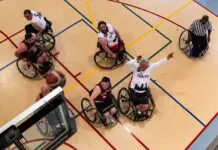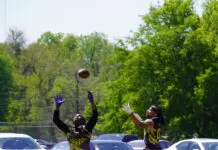Remember the dusty ping-pong table in your friend’s garage? Remember tapping a ball back and forth in some basement?
Now put that aside. There’s more to table tennis than ping-pong, say passionate players of the world’s most popular sport.
It’s about time the sport got its due respect in Oklahoma, they say.
That may be easier said than done, says Kelly Boyce, president of the Tulsa Table Tennis Club.
“Table tennis is the number one sport in the world, in terms of participation,” Boyce says.
Internationally, and especially in European and Asian countries, a large framework exists to help elevate players’ table tennis games to the next level.
In Oklahoma, table tennis is confined to a grassroots level. In Tulsa, players use their own equipment in rooms provided by parks departments in recreation centers.
Oklahoma City’s club operates out of Crossroads Mall, says Britt Salter, club president. Tulsa’s club meets at either the Dawson Community Center or Bixby Community Center for their play.
Everybody’s welcome, club presidents say. One sure way to learn more about table tennis is to come out and join members some night.
“Don’t be intimidated,” says Robert Kyker, who plays in Tulsa. “Nobody gets upset if somebody’s not good enough.”
While table tennis players in the state are serious about their games, they’re also serious about having fun with it.
“Everybody loves ping-pong,” Boyce says. “It’s a sport to really enjoy and love playing. That’s why it’s number one in the world.”
Kyker was quick to dispel one of the biggest misconceptions he says he hears about table tennis – that it’s not athletic.
Kyker says serious players train regularly to stay and shape, and over the course of a tournament, he loses several pounds through sweat and exertion.
“You’re totally exhausted by the end of the day,” he says, noting that the physical and mental components add up to a workout. “It’s like chess at 100 miles per hour.”
If there’s one thing the state’s players wished for table tennis, it’s that their Sooner brethren played more of it.
Boyce got hooked on tennis in the early 1970s, when the popularity of the sport worldwide really took off thanks to “ping pong diplomacy,” when international matches helped sooth tensions between America and communist China.
Kyker started playing while attending the University of Oklahoma in 1974, where the large population of international students meant table tennis was a popular sport.
Indeed, table tennis is huge everywhere but in America, Salter says. And that lack of visibility has hurt the nation’s competitiveness on the international scene.
“In America, we’re pretty terrible actually,” Salter says. “But we’re getting better.”
Without structured support for young players, with programs and chances for advancement, Boyce foresees a bleak future for America’s table tennis.
Salter is more optimistic, pointing to some young guns who are starting to pop up on the radar on the national scene.
For some, the future of table tennis in America is bright – and might just begin in Oklahoma.
For more on the Oklahoma City Table Tennis Club, visit www.okctt.wordpress.com. For more on Tulsa’s Table Tennis Club, visit www.tulsatabletennis.com.
























